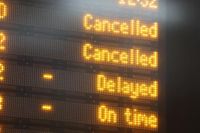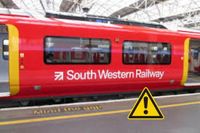Train travel across Great Britain has faced a turbulent year, with millions of scheduled stops cancelled, frustrated passengers left stranded, and rail operators scrambling to improve communication and support. This week, a new initiative has rolled out nationwide, aiming to help travellers navigate the unpredictability of the rail network: real-time disruption videos called Visual Disruption Maps. The launch comes at a crucial moment, as government plans to renationalise rail services are underway and passengers continue to voice concerns over reliability, safety, and access to clear information.
According to BBC analysis of Office of Rail and Road data, about three million train stops were cancelled out of 89 million scheduled in Britain in the year to August 2025. City Thameslink in London topped the charts for cancellations among Britain’s busiest stations, with one in 13 scheduled stops failing to materialise. Earlswood in Surrey wasn’t far behind, with one in 10 stops cancelled, leaving students like Cat Edge frequently late for university despite her best efforts. "It's so stressful, especially if when you get on a train, it's dark and you don't know whether it's actually going to stop at your station. It's scary," Cat told BBC News. She added that late-night reliability is especially critical: "That's when it's the worst and you're the most vulnerable."
The situation is no less dire in rural areas. Sheila O'Donnell, 73, from Arnside in Cumbria, recounted to BBC the night she was forced to walk 4.5 miles home along a dark country lane after a cancellation left her stranded and unable to find a taxi. "It happens so often, I'm resigned to it," she said. "From 22:30 to midnight, I had to walk home along the dark country lane. Hardly any lights and I needed the torch on my phone." In Macclesfield, Peter Howard, a commuter, became so disillusioned with repeated cancellations that he switched to driving. "I just got fed up with it," he said. "I thought I'm not taking that risk any more and I ended up driving." He’s since returned to train travel, noting some improvement, but the scars of missed family moments linger: "There'd be that sense of disappointment - 'dad's not here, he should have been'."
The government has taken notice. The Department for Transport says it is determined to "drive up standards" and is pushing forward with what it describes as the biggest overhaul of the railways in a generation. Under current plans, a new body called Great British Railways will oversee the network in England, Wales, and Scotland, with all services expected to be publicly owned by the end of 2027. A spokesperson told BBC that operators would have to meet "rigorous, bespoke standards" and that "positive signs of progress" are already emerging, with overall cancellations starting to fall in the most recent reporting period. However, the annual cancellation rate still ticked up slightly, from 3.2% to 3.3%.
Rail operators, meanwhile, are keen to demonstrate their commitment to passengers. The Rail Delivery Group, which represents train companies and Network Rail, apologised for the inconvenience and pointed to new tools designed to help customers cope with disruption. Chief among them is the Visual Disruption Maps initiative, part of the Smarter Information, Smarter Journeys programme. This cross-industry effort brings together the Rail Delivery Group, Network Rail, and train operators to deliver clearer, more accessible information during service interruptions.
The Visual Disruption Maps are short, real-time videos featuring a presenter in front of a map of the rail network. Produced within 30 minutes of an incident being confirmed, each video explains what has happened, how services are affected, and what travellers should do next. They are available on the National Rail Enquiries website, app, and social media, with subtitles and British Sign Language included where possible to ensure accessibility. The service operates nationally, seven days a week—Monday to Friday from 7am to 10pm and weekends from 7am to 7pm.
Jacqueline Starr, Executive Chair and CEO of Rail Delivery Group, commented on the rollout: "Delays can be stressful, especially when they disrupt plans, moments, and time with your loved ones. We always do our best to keep trains running smoothly, but when disruption does happen, customers want clear and timely information they can trust. Visual Disruption Maps bring a human face and voice to real-time events, helping people to travel with confidence when journeys don’t go as planned. By including subtitles and British Sign Language wherever possible, we are ensuring these updates are accessible to everyone. This national rollout marks a step in how we communicate with customers and demonstrates our commitment to putting their needs first."
The initiative builds on the success of planned disruption videos, launched in December 2024, which have since been viewed nearly 700,000 times. Customer feedback has been overwhelmingly positive: 93% found the videos useful, 87% were satisfied with the information, and 74% said they would recommend the videos to other rail users. Passengers particularly praised the clarity and the human presentation style, seeing the videos as a forward-thinking way for the railway to keep people informed.
Malcolm Pitt, Head of Customer Experience and Accessibility at Network Rail, echoed these sentiments: "We know how frustrating it is when passengers’ journeys are disrupted – and that frustration is made worse when they can’t find out what’s happening or are unable to find the information needed to get them where they need to be. The roll out of the visual disruption maps is a great example of the industry working together, putting customers first by providing clear, real-time information that passengers can access quickly to see what’s happening and plan their onward journeys."
This week, the need for clear information was especially acute. From September 22 to 26, South Western trains are facing widespread cancellations and diversions due to maintenance work, with lines between Axminster and Exeter closed and replacement buses running. Late evening services in the Haslemere area are also affected, and passengers are warned that bulky luggage, cycles, and prams cannot be carried on replacement buses. The South Western Railway website cautions: "Late evening and early morning services may need to be altered for emergency repairs or planned work. We are sorry that bulky luggage, cycles and prams cannot be carried on the replacement bus services. Please check if you are planning to travel after 11pm or before 5.30am as buses may replace trains at short notice."
Meanwhile, on the morning of September 23, all c2c lines in Essex were blocked due to a signalling fault at Dagenham Dock, causing delays and cancellations across the network. Disruption was expected until 11am, and passengers were advised they may be entitled to compensation for delays over 15 minutes.
Campaigners argue that more must be done. Michael Solomon Williams from Campaign for Better Transport called the scale of cancellations "simply unacceptable" and pressed for "tougher targets, automatic compensation, and proper investment to restore trust." He emphasised the broader stakes: "We need a reliable, affordable and accessible rail network to deliver economic growth, increase productivity and reduce carbon emissions."
With new tools like Visual Disruption Maps, a renewed focus on accessibility, and sweeping changes promised by both government and industry, Britain’s railways are at a crossroads. For passengers, the hope is that these efforts will translate into fewer missed connections, safer journeys, and a rail network they can finally count on.






